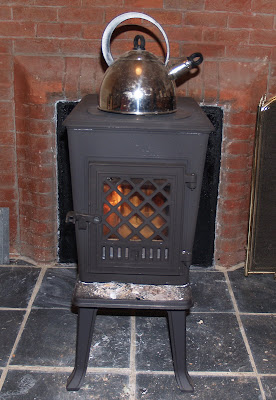Seafood party dish served at inaugural lunch
How about this? The complete menu, with recipes, for yesterday's inaugural lunch. I'm slightly appalled at the "winter vegetables" selection - asparagus, carrots, baby Brussels sprouts, wax beans - half of which probably had jet lag. But this seafood starter sounds like a good dish to make ahead when you're having a dinner party. (Although I suspect some of the seafood will need substituting for better sustainability.)
Seafood Stew
for 10 servings
6 (1 Lb) Maine lobsters
20 medium size Sea scallops
36 large shrimp, peel, cleaned and tail removed, approx. 2 lbs.
10 (1 oz) pieces of black cod
½ cup small dice carrots
½ cup small dice celery
½ cup small dice leek
½ cup small dice Idaho potato
1 teaspoon kosher salt
1 teaspoon ground white pepper or black pepper
¼ teaspoon ground nutmeg
1 quart heavy cream
1 cup dry vermouth (can be made without)
10 (5 inch) puff pastry rounds
Equipment
10 (3 ½ inch) terrines/ramekins or serving dish of your choice
Directions
1. Bring 1 gallon of water to a boil; poach lobsters, then shrimp, then black cod and last scallops. After seafood is cooked, remove from water; reserve water and bring to boil.
2. Cook all vegetables in liquid that was used for the seafood, remove vegetables when tender. Allow the liquid to continue to boil until only 1qt of liquid remains. This will be the base for the sauce.
3. Bring seafood liquid back to a boil and add the vermouth and heavy cream and reduce by half,
season with salt, white pepper and nutmeg to taste. You have reached your desired thickness when the sauce will cover the back of a wooden spoon. Set aside to cool.
4. Cut Maine lobster, shrimp and scallops into bite size pieces.
5. Pre-heat oven at 400 degrees.
6. Fold seafood and vegetables into cool sauce, being careful not to mix too much as this will break up the seafood. Scoop mixture into terrines or ovenproof baking dish of your choice.
7. Cover terrines with puff pastry rounds, brush them with egg wash and bake them until golden
brown about 8-10 minutes, allow to cool for 5 minutes before serving. You can cook this 2-3 hours ahead of time and keep warm at 150 F degrees.
*All seafood can be substituted with other favourite options of your choice and availability.
Here's the link to the whole inaugural meal, with recipes - there's a rather good cherry chutney for duck breasts, and a lovely recipe for cooking sweet potato with molasses. Thanks to Lifehacker for showing me the way in the first place.












